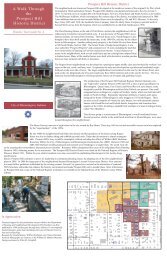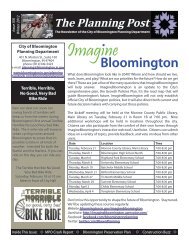Peak Oil Task Force Report - City of Bloomington - State of Indiana
Peak Oil Task Force Report - City of Bloomington - State of Indiana
Peak Oil Task Force Report - City of Bloomington - State of Indiana
Create successful ePaper yourself
Turn your PDF publications into a flip-book with our unique Google optimized e-Paper software.
VULNERABILITIES: PUBLIC TRANSIT<br />
Currently, public transit comprises a small slice <strong>of</strong> the transportation pie. Only a small<br />
portion <strong>of</strong> the population makes use <strong>of</strong> it. As discussed earlier, only 2.8 percent <strong>of</strong> all work<br />
commutes are on public transit. 160 Similarly, a study conducted by the <strong>Indiana</strong> Department<br />
<strong>of</strong> Transportation in 2008 found that public transportation serves just 1.4 percent <strong>of</strong> all<br />
<strong>Bloomington</strong>’s travel demands. 161<br />
1. Fuel prices will be volatile and will increase.<br />
While transit is <strong>of</strong>ten seen as an alternative to driving when gas prices are high, it is<br />
important to remember that transit itself is vulnerable to increased fuel costs and<br />
decreased revenue. According to a recent article in The New York Times, “more people used<br />
transit in 2008 than in any year since 1956,” but at the same time, many “transit systems<br />
across the country are raising fares and cutting service as the tax revenue they rely on<br />
plummets during the recession.” 162 This constitutes a problem, considering that extreme<br />
swings in fuel prices are expected to continue as petroleum supplies diminish worldwide.<br />
As discussed earlier, high fuel prices are predicted to drive demand destruction and stifle<br />
economic activity, leading to recessions and wild price fluctuations.<br />
In 2008, as fuel prices soared, BT was forced to reduce the frequency <strong>of</strong> its service on some<br />
campus routes. This was because IU was not able to increase its contributions to BT to keep<br />
up with fuel costs. IU is only able to commit to a reimbursement schedule on a biannual<br />
basis, due to its state‐mandated budgeting process. BT could not receive additional funding<br />
from IU in a non‐budget year. The IU campus bus system itself also reduced service due to<br />
the same budgeting process dilemma.<br />
160 2000 U.S. Census<br />
161 This compares to a “transit share” <strong>of</strong> 0.4 percent in the <strong>Indiana</strong>polis metro area. Overall, in <strong>Indiana</strong>, the<br />
current urban transit mode share for <strong>Indiana</strong> is 0.46 percent <strong>of</strong> all trips. <strong>Indiana</strong> Department <strong>of</strong><br />
Transportation, December 2008, Executive Summary, <strong>Indiana</strong> Mass Transit Studies PL 203‐2007.<br />
162 Michael Cooper, “Transit Use Hit Five‐Decade High in 2008 as Gas Prices Rose,” The New York Times,<br />
March 9, 2009. http://www.nytimes.com/2009/03/09/us/09transit.html?_r=1<br />
<strong>Report</strong> <strong>of</strong> the <strong>Bloomington</strong> <strong>Peak</strong> <strong>Oil</strong> <strong>Task</strong> <strong>Force</strong><br />
129









